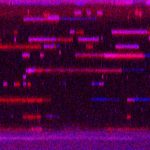Imagine a city like Venice, Italy, where boats putter through a network of watery canals transporting people to homes that line the banks and police vessels occasionally dash to 911 calls. The tide ebbs and flows on a 12-hour cycle with high tide at dawn and dusk and low tide at noon and midnight. At high tide, the brimming waterways are all connected, allowing police to quickly reach homes and solve problems. But at low tide, some of the canals are cut off and response time is slower. Luckily for this imaginary city, 911 calls spike at dawn and dusk in sync with high tide, and police respond rapidly to incidents and keep law and order.
For Dr. Bokai Zhu, assistant professor of medicine at Pitt, this peaceful Venetian city represents a healthy cell where proteins are in balance known as proteostasis. Misfolded proteins are troublemakers who disrupt proteostasis peace and damage cells. Protein complexes called spliceosomes act as police boats, enforcing the law by turning on unfolded protein response (UPR) genes, which degrade wayward proteins or turn on other genes that help them fold correctly.

Bokai Zhu, Ph.D.
Zhu’s research focuses on understanding the 12-hour clock that regulates proteostasis and other cellular processes. Loss of proteostasis and aggregation of misfolded proteins are culprits of age-related diseases such as Alzheimer’s and Parkinson’s, so understanding cells’ bidaily rhythms could hold clues to new treatments or preventative therapies.
In a new study, published this week in Science Advances, Zhu and his team found that tiny structures in the cell’s nucleus called nuclear speckles act as the cell’s waterways. Using time-lapse imaging of single mouse cells, they show that the state of nuclear speckles oscillates on a 12-hour cycle.
“Like high tide, nuclear speckles are fluid and dispersed in the early morning and early afternoon, which leads to greater activation of UPR genes. Similar to an ebbing tide, nuclear speckles condense together and become stagnant in the late morning and evening, reducing activation of UPR genes,” explained Zhu.
The connection between the tides and cellular rhythms may be no coincidence. Rather, this 12-hour clock — which is shared by mammals, mollusks and more and functions independently of more familiar 24-hour rhythms — may stem from life’s origin in the ocean, according to Zhu. Now, he says this bidaily cycle may help our body cope with higher metabolic demands at dawn and dusk as we transition between periods of rest and activity.
But the 12-hour clock may become disrupted with age. Zhu and his team found that across mice lifespans, the gene that controls nuclear speckle fluidity gradually declines, leading to accumulation of misfolded proteins.
“For the Venice metaphor, let’s say that climate change causes the average water level to keep dropping, leading to more and more pools of disconnected water,” said Zhu. “As police boats struggle to navigate through these dried-up canals, the consequence is high crime rates and unstable society.”
These findings suggest that genes or proteins that regulate nuclear speckle dynamics could be new targets for treating diseases caused by dysregulated proteostasis.









